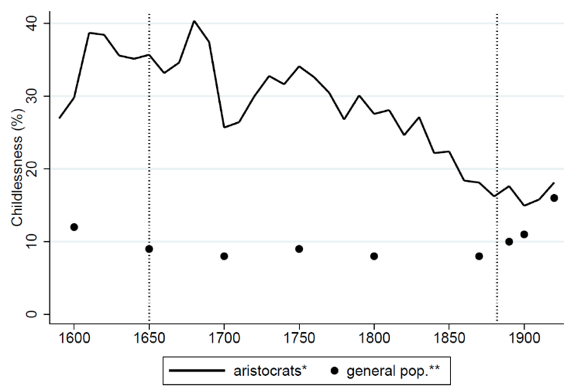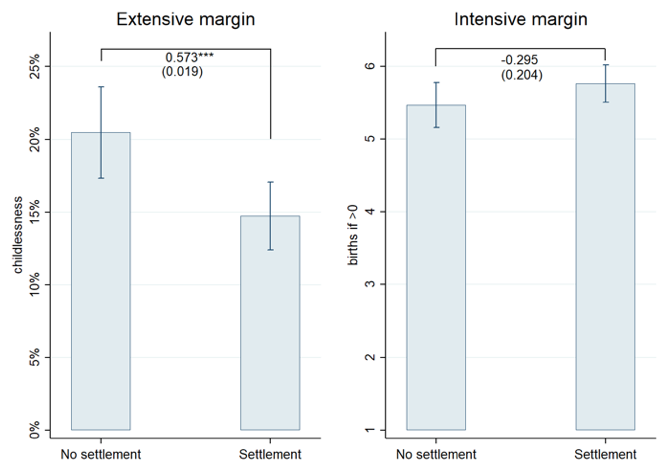Inheritance practices have long attracted the attention of economists. Adam Smith was scathing in his criticism of primogeniture and entailment of the land.1 He argued that these laws increased inequality, “making beggars” of all but the first-born (Smith 1776). Recent studies that suggest that wealth inequality and the incidence of inherited wealth are both rising have once more highlighted the impact of inheritance practices (Piketty 2011, Atkinson 2013, Saez and Zucman 2016).
The economic effects of any inheritance scheme depend on fertility choices (Stiglitz 1969, Atkinson and Harrison 1978). Most importantly, they depend on the production of an heir. Despite this, modern studies of inheritance ignore both the effects of inheritance rules on fertility choices in the extensive margin, and how fertility concerns may determine the type of inheritance used.
Our recent research finds new evidence of a two-way link between inheritance and fertility for the British peerage, the world’s richest elite.
The world’s richest elite
It is hard to exaggerate the riches of the 300 families in the peerage (Cannadine 1990).2 For example, while the average member of the top 1% in the US earns $1.3 million a year (Wolff 2012), peers earned $2.5 million (in 2008 US dollars) in the 19th century (Goñi 2018). Though in decline, the peerage remains rich: 68 peers were included in the 1,000 richest in Britain in 2000 (Cahill 2002).
The peerage was not pre-destined to be at the top of the distribution. Demographics were not on their side: around 1600, between 30% and 40% of married women in the peerage were childless. For the average commoner, the corresponding rate was only 10% (Figure 1). This threatened the survival of aristocratic lineages.
Figure 1 Childlessness rates, by marriage decade
Notes: * sample: married women whose father is a peer; ** sources: Wrigley et al (1997), Anderson (1998).
So, how did these aristocratic lineages survive?
As suggested by Adam Smith, inheritance practices helped British aristocrats to consolidate their wealth, and their position at the top of the distribution. This is only part of the picture. In a recent paper (Gobbi and Goñi 2018) we show that the inheritance practices of the aristocracy boosted fertility decisions in the extensive margin (in other words, having children or not). Inheritance rules contributed to the perpetuation of the British elite not only by preventing family estates to break, but also through changing fertility incentives.
An inheritance scheme that boosts fertility
From 1650 to 1882, inheritance in the British aristocracy was regulated by settlements. Settlements combined male primogeniture with a one-generation entail of the land. In the textbook case, the family head and the heir signed a settlement by which the heir committed to passing down the estate, unbroken, to the next generation (Habakkuk 1950). The social convention was strong. Few heirs refused to sign a settlement with their fathers (Stone and Stone 1984). Importantly, settlements were signed upon the heir’s marriage, as they also included provisions for the wife (Bonfield 1979).
Why would settlements affect fertility? When an individual was subject to a settlement, he could not break the family estate, sell it, or mortgage it. He may choose to have children, if he preferred the large, ‘untouched’ inheritance to go to his offspring. Otherwise a distant relative would have inherited the estates. For the settlement to change fertility incentives, however, the family head had to survive until his heir’s marriage. If he did not, the settlement was not signed, and the heir could have sold parts of the family estate.
To estimate the effect of settlements on fertility we used genealogical data collected by Hollingsworth (1964) from peerage records. These data do not state who signed a settlement. We can nevertheless identify families in which the father died after the heir’s wedding, and hence, in which a settlement was signed, and families in which the father died before wedding, and in which the heir would not have signed a settlement.
Figure 2 summarises the results. Families signing a settlement had significantly lower childlessness rates. The magnitude of the effect is larger when we control for variables that potentially affected childlessness, such as the age of the spouse at marriage, or the number of stillbirths. Our results are robust to including family fixed effects, which capture any genetic, cultural, religious, or socioeconomic predisposition towards childlessness. In contrast, we do not find an effect of settlements on the intensive margin of fertility (births conditional on having at least one child).
Figure 2 Effect of signing a settlement on the extensive and intensive margin of fertility for aristocrats
Note: We assume that a family signed a settlement (did not sign a settlement) if the father died after (before) his heir’s wedding.
It is possible that individuals may have chosennot to sign a settlement by delaying marriage until their father’s death. To address this, we exploit the birth order of the heir. Since families could not control the gender of their children, a male heir might not have been born until the second or third birth. In these families, the father is older, more likely to die before the heir’s wedding, and hence, exogenouslyless likely to sign a settlement.
Instrumenting settlements with the heir’s birth order, we find that signing a settlement increased the extensive margin of fertility by 83.5%, pushing childlessness rates close to the 'natural' rate of 2.4% (Tietze 1957). In other words, settlements contributed to the survival of noble family lineages.
Permanent entails in Scotland
In Scotland, peers could use permanent entails (Habakkuk 1994), unlike in England. Because these entails did not have to be renewed every generation, it should not have mattered for fertility whether the father died before or after his heir’s wedding. Our estimates for Scottish peers are close to zero, and significantly different from our benchmark results. This strongly suggests that we have captured the causal effect of settlements, rather than confounding factors correlated with the father dying before or after his heir’s wedding.
Why would an heir sign a settlement?
A settlement restricts an heir's powers to manage the family wealth, so to answer this we develop a simple model of inheritance and fertility. We relax the assumption of exponential discounting across generations, commonly used in bequest models (Barro 1974). Instead, we introduce dynastic preferences, so that individuals would value their children's well-being similarly to that of the future generations. This type of discounting is appealing for two reasons:
- Dynastic preferences are well-suited for the aristocracy and other wealthy elites.
- Dynastic preferences rationalise inheritance schemes that restrict successors.
In the model, the family head prefers to use such a scheme to provide for his grandson. For the heir, signing a settlement – even if this restricts him in managing the estate – is a credible commitment to have children, which ensures that his father would pass down a larger share of the estate.
In sum, our model predicts that concerns over the production of an heir may shape inheritance rules – in particular, rules that restrict successors.
Lessons for today
British peers were the wealthiest elite on earth. However, from 1650 to 1882 they did not freely dispose of their estates. On their marriage, they signed a settlement, renouncing to sell or mortgage parts of the family estate before passing it down. We find that such arrangements reduced the high rates of childlessness in the aristocracy, ensuring its survival.
Should we care about an elite who spent their time in debutanteballs and fox-hunting, and who lived “on money that were invested they hardly knew where?” (Orwell 1968). In light of the recent surge in inequality and the importance of inherited wealth, we argue that history can teach important lessons. We show that inheritance models treating fertility as exogenous can be misleading, because inheritance schemes affect fertility decisions which, in turn, can shape inheritance practices.
In addition, the study of settlements allows us to understand inheritance practices that restrict successors, which are increasingly popular. For example, trusts are likely the most popular inheritance scheme among the top 0.1% in the US (Wolff and Gittleman 2014).
Since Adam Smith, many have argued that inheritance schemes that restrict successors can perpetuate elite lineages. We suggest that they can so not only by consolidating wealth, but also through changing fertility incentives.
References
Anderson, M (1998), “Highly Restricted Fertility: Very Small Families in the British Fertility Decline”, Population Studies 52(2): 177-199.
Atkinson, A B (2013), “Wealth and Inheritance in Britain from 1896 to the Present”, working paper, Oxford University.
Atkinson, A B, and A J Harrison (1978), Distribution of Total Wealth in Britain, Cambridge University Press.
Barro, R (1974), “Are Government Bonds Net Wealth?”, Journal of Political Economy 82(6): 1095-1117.
Bonfield, L (1979), “Marriage Settlements and the `Rise of Great Estates': The Demographic Aspect”, The Economic History Review 32(4): 483-493.
Cahill, K (2001), Who Owns Britain, Canongate Books Ltd.
Cannadine, D (1990), The Decline and Fall of the British Aristocracy, Yale University Press.
Gobbi, P E, and M Goñi (2018), “Childless Aristocrats. Inheritance and the extensive margin of fertility”, CEPR discussion paper 12744.
Goñi, M (2018), “Assortative Matching at the top of the Distribution. Evidence from the World's Most Exclusive Marriage Market”, unpublished online appendix.
Habakkuk, H J (1950), “Marriage Settlements in the Eighteenth Century”, Transactions of the Royal Historical Society.
Hollingsworth, T H (1964), “The Demography of the British Peerage”, Population Studies, volume supplement.
Hollingsworth, T H (2001), “Hollingsworth Genealogical Data on the British Peerage”, Cambridge Group for the History of Population and Social Structure.
Orwell, G (1968), "Part I: England your England", in S Orwell and I Angus, (eds.),The Lion and the Unicorn: Socialism and the English Genius, The Collected Essays Journalism and Letters of George Orwell. Harcourt, Brace & World Inc.
Piketty, T (2011), “On the Long-Run Evolution of Inheritance: France 1820-2050”, The Quarterly Journal of Economics 126(3): 1071.
Saez, E, and G Sucman (2016), “Wealth Inequality in the United States since 1913: Evidence from Capitalized Income Tax Data”, The Quarterly Journal of Economics 131(2): 519-578
Smith, A (1776), An Inquiry into the Nature and Causes of the Wealth of Nations, reprint, Modern Library, 1937.
Stiglitz, J (1969), “Distribution of Income and Wealth Among Individuals”, Econometrica 37(3): 382-397.
Stone, L, and J F Stone (1984), An Open Elite? England 1540-1880, Clarendon Press.
Tietze, C (1957), “Reproductive Span and Rate of Reproduction Among Hutterite Women”, Fertility and Sterility 8(1): 89-97.
Wolff, E N (2012), “The Asset Price Meltdown and the Wealth of the Middle Class”, NBER working paper 18559.
Wrigley, E A, R S Davies, J E Oeppen, and R S Schoeld (1997), English Population History from Family Reconstitution: 1580-1837, Cambridge University Press.
Wolff, E N, and M Gittleman (2014), “Inheritances and the distribution of wealth or whatever happened to the great inheritance boom?”, The Journal of Economic Inequality 12(4): 439-468.
Endnotes
[1] Land entails are arrangements that restrict the successors capacity to break the family estate; i.e., sell parts of the land, mortgage it, etc.
[2] After 1900, the size of the peerage grew to 900 families.




